Marketing Analysis of Healthcare Services: HCSC Case Study Report
VerifiedAdded on 2019/10/18
|6
|1070
|112
Report
AI Summary
This report provides an analysis of the healthcare services offered by Health Care Service Corporation (HCSC), a leading customer-owned health insurance company in the United States. The analysis is conducted based on the five I's of marketing: intangibility, inconsistency, inventory, inseparability, and interaction with consumers. The report examines each of these aspects in the context of HCSC's operations, highlighting the challenges and opportunities associated with each. For instance, the report addresses the intangibility of services and the need to prove benefits to consumers, the inconsistency in service delivery, and the importance of consumer interaction. The report then offers several recommendations to improve HCSC's marketing strategies, such as leveraging digital marketing to address intangibility, standardizing services through provider training to address inconsistency, and reducing unutilized services by analyzing demand. Finally, it emphasizes the importance of training, motivation, and teamwork to improve consumer interaction and create a patient-centered approach.
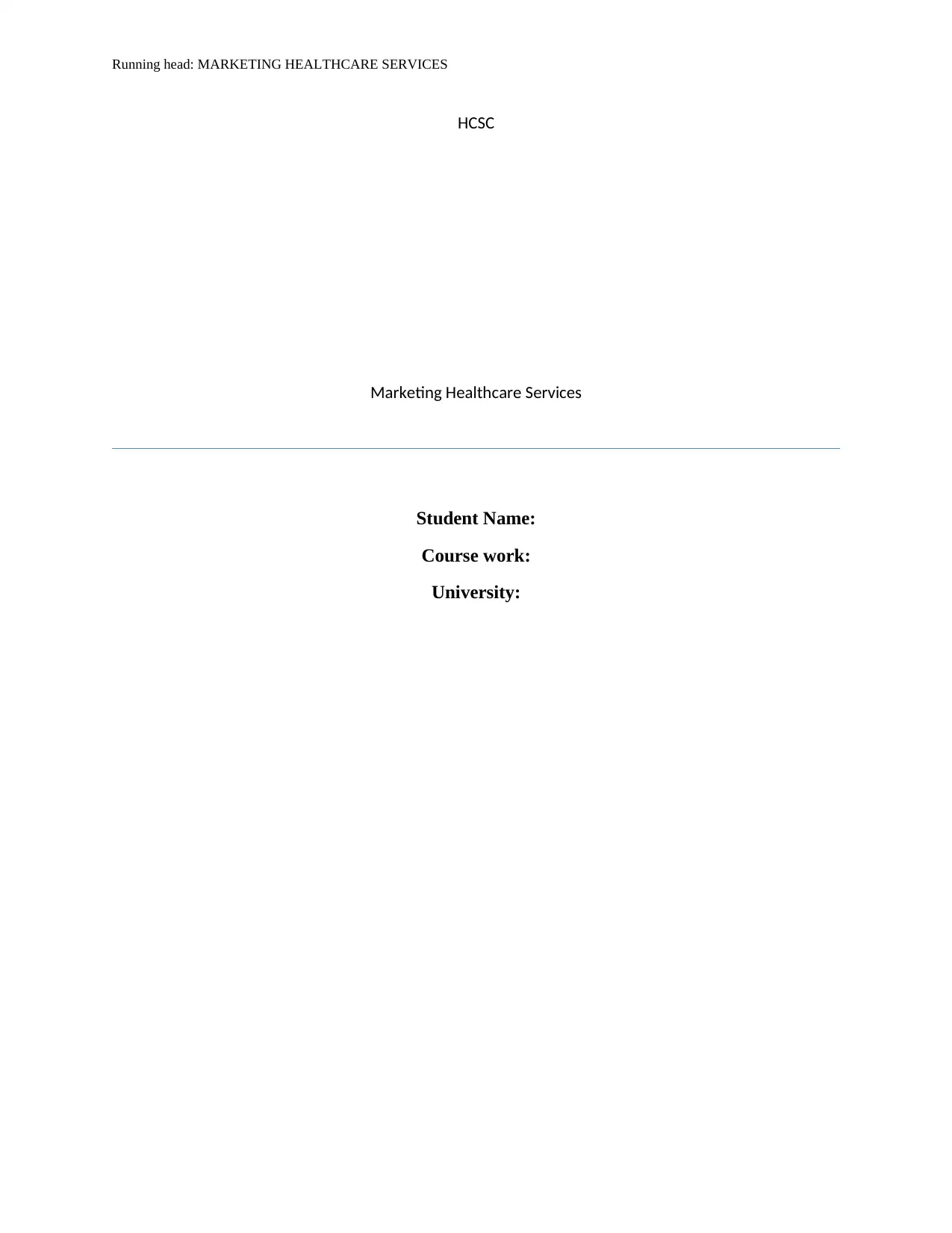
Running head: MARKETING HEALTHCARE SERVICES
HCSC
Marketing Healthcare Services
Student Name:
Course work:
University:
HCSC
Marketing Healthcare Services
Student Name:
Course work:
University:
Paraphrase This Document
Need a fresh take? Get an instant paraphrase of this document with our AI Paraphraser
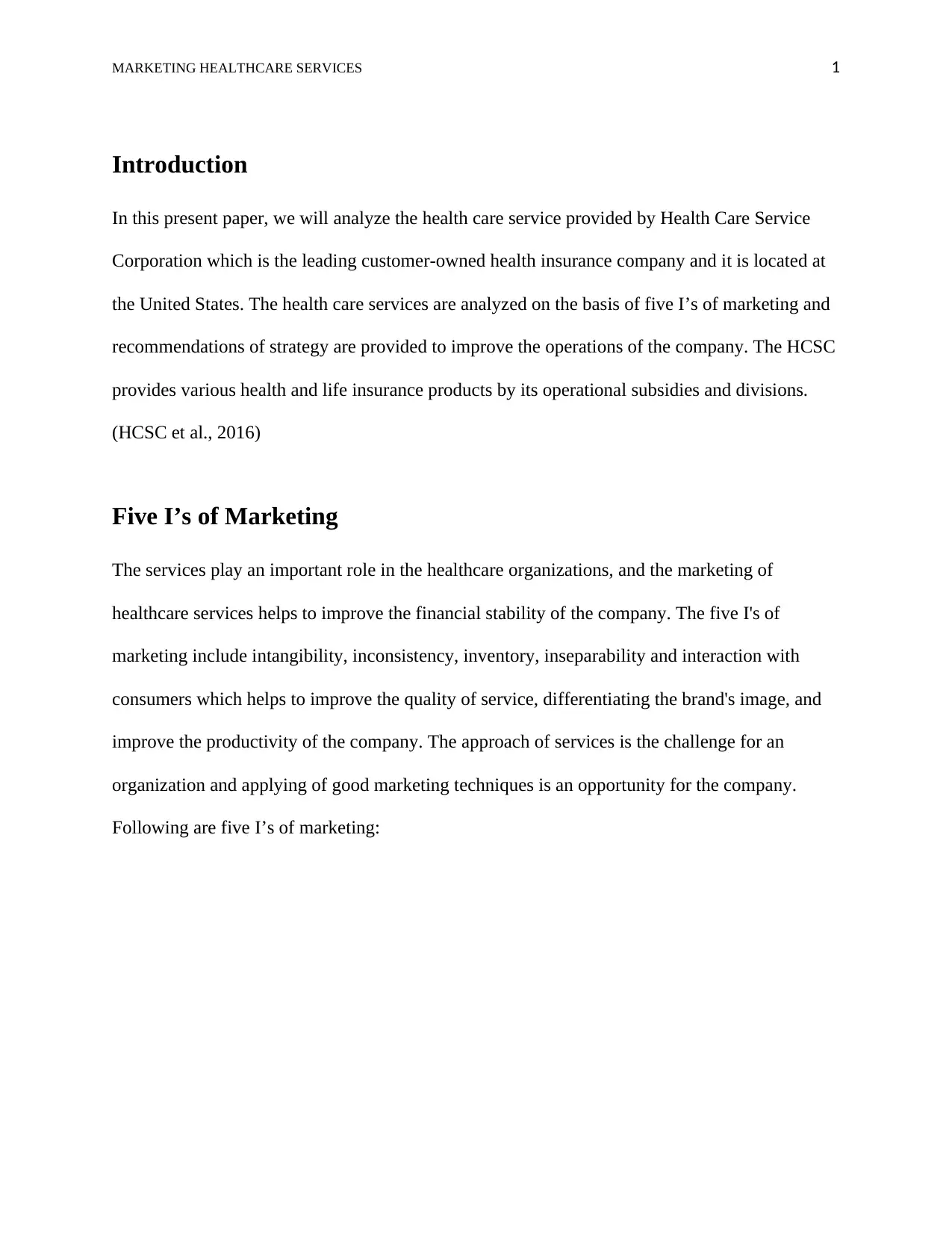
MARKETING HEALTHCARE SERVICES 1
Introduction
In this present paper, we will analyze the health care service provided by Health Care Service
Corporation which is the leading customer-owned health insurance company and it is located at
the United States. The health care services are analyzed on the basis of five I’s of marketing and
recommendations of strategy are provided to improve the operations of the company. The HCSC
provides various health and life insurance products by its operational subsidies and divisions.
(HCSC et al., 2016)
Five I’s of Marketing
The services play an important role in the healthcare organizations, and the marketing of
healthcare services helps to improve the financial stability of the company. The five I's of
marketing include intangibility, inconsistency, inventory, inseparability and interaction with
consumers which helps to improve the quality of service, differentiating the brand's image, and
improve the productivity of the company. The approach of services is the challenge for an
organization and applying of good marketing techniques is an opportunity for the company.
Following are five I’s of marketing:
Introduction
In this present paper, we will analyze the health care service provided by Health Care Service
Corporation which is the leading customer-owned health insurance company and it is located at
the United States. The health care services are analyzed on the basis of five I’s of marketing and
recommendations of strategy are provided to improve the operations of the company. The HCSC
provides various health and life insurance products by its operational subsidies and divisions.
(HCSC et al., 2016)
Five I’s of Marketing
The services play an important role in the healthcare organizations, and the marketing of
healthcare services helps to improve the financial stability of the company. The five I's of
marketing include intangibility, inconsistency, inventory, inseparability and interaction with
consumers which helps to improve the quality of service, differentiating the brand's image, and
improve the productivity of the company. The approach of services is the challenge for an
organization and applying of good marketing techniques is an opportunity for the company.
Following are five I’s of marketing:
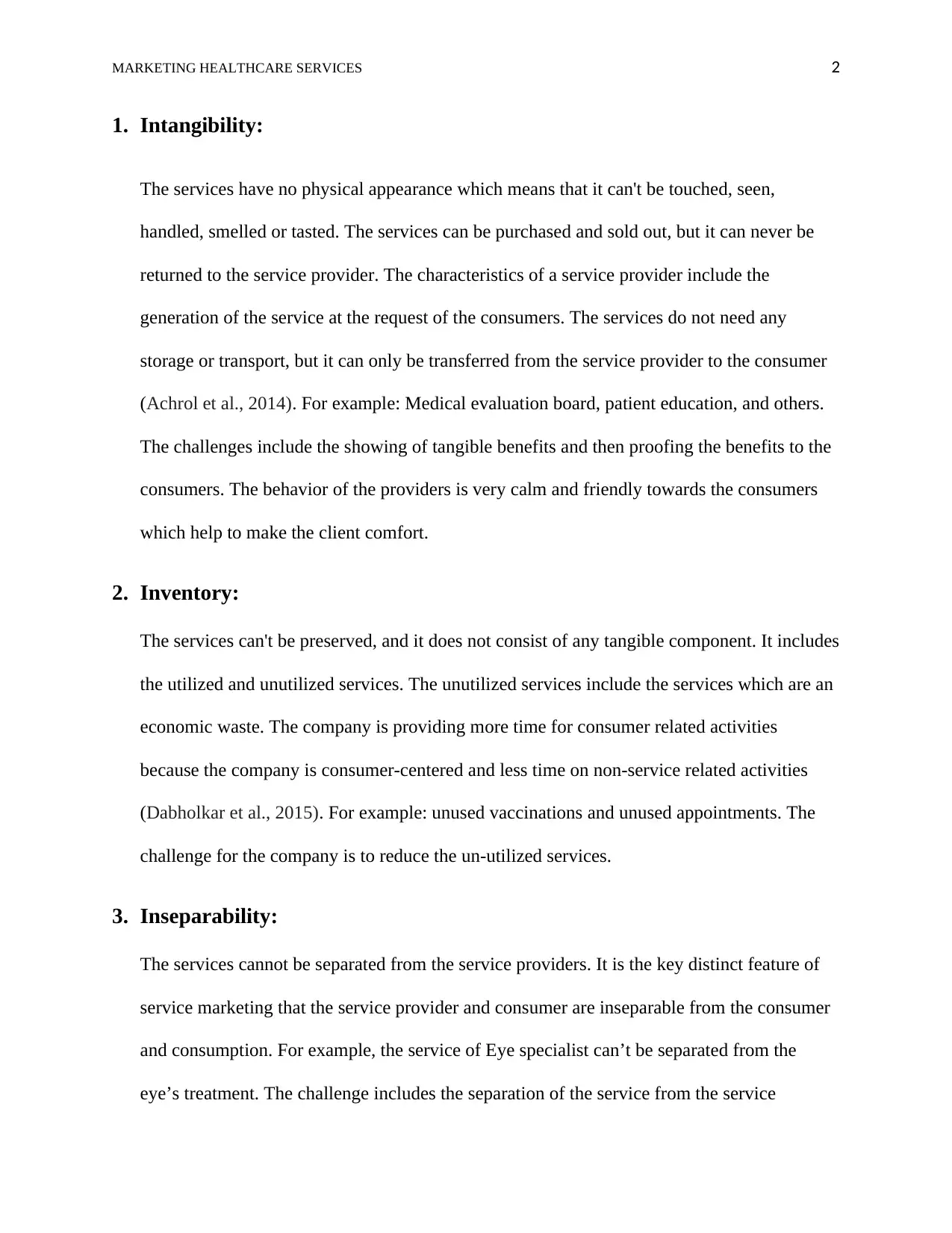
MARKETING HEALTHCARE SERVICES 2
1. Intangibility:
The services have no physical appearance which means that it can't be touched, seen,
handled, smelled or tasted. The services can be purchased and sold out, but it can never be
returned to the service provider. The characteristics of a service provider include the
generation of the service at the request of the consumers. The services do not need any
storage or transport, but it can only be transferred from the service provider to the consumer
(Achrol et al., 2014). For example: Medical evaluation board, patient education, and others.
The challenges include the showing of tangible benefits and then proofing the benefits to the
consumers. The behavior of the providers is very calm and friendly towards the consumers
which help to make the client comfort.
2. Inventory:
The services can't be preserved, and it does not consist of any tangible component. It includes
the utilized and unutilized services. The unutilized services include the services which are an
economic waste. The company is providing more time for consumer related activities
because the company is consumer-centered and less time on non-service related activities
(Dabholkar et al., 2015). For example: unused vaccinations and unused appointments. The
challenge for the company is to reduce the un-utilized services.
3. Inseparability:
The services cannot be separated from the service providers. It is the key distinct feature of
service marketing that the service provider and consumer are inseparable from the consumer
and consumption. For example, the service of Eye specialist can’t be separated from the
eye’s treatment. The challenge includes the separation of the service from the service
1. Intangibility:
The services have no physical appearance which means that it can't be touched, seen,
handled, smelled or tasted. The services can be purchased and sold out, but it can never be
returned to the service provider. The characteristics of a service provider include the
generation of the service at the request of the consumers. The services do not need any
storage or transport, but it can only be transferred from the service provider to the consumer
(Achrol et al., 2014). For example: Medical evaluation board, patient education, and others.
The challenges include the showing of tangible benefits and then proofing the benefits to the
consumers. The behavior of the providers is very calm and friendly towards the consumers
which help to make the client comfort.
2. Inventory:
The services can't be preserved, and it does not consist of any tangible component. It includes
the utilized and unutilized services. The unutilized services include the services which are an
economic waste. The company is providing more time for consumer related activities
because the company is consumer-centered and less time on non-service related activities
(Dabholkar et al., 2015). For example: unused vaccinations and unused appointments. The
challenge for the company is to reduce the un-utilized services.
3. Inseparability:
The services cannot be separated from the service providers. It is the key distinct feature of
service marketing that the service provider and consumer are inseparable from the consumer
and consumption. For example, the service of Eye specialist can’t be separated from the
eye’s treatment. The challenge includes the separation of the service from the service
⊘ This is a preview!⊘
Do you want full access?
Subscribe today to unlock all pages.

Trusted by 1+ million students worldwide
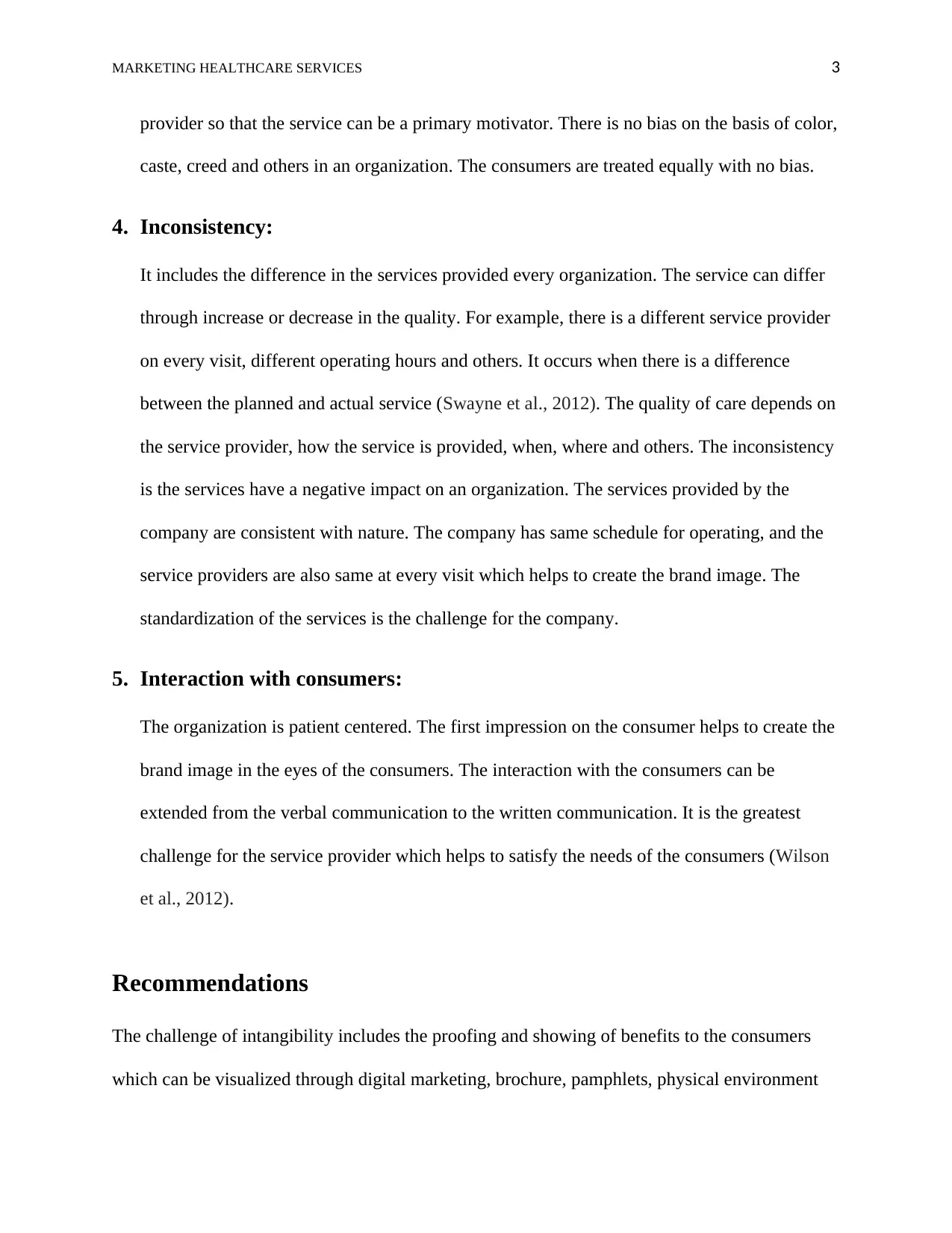
MARKETING HEALTHCARE SERVICES 3
provider so that the service can be a primary motivator. There is no bias on the basis of color,
caste, creed and others in an organization. The consumers are treated equally with no bias.
4. Inconsistency:
It includes the difference in the services provided every organization. The service can differ
through increase or decrease in the quality. For example, there is a different service provider
on every visit, different operating hours and others. It occurs when there is a difference
between the planned and actual service (Swayne et al., 2012). The quality of care depends on
the service provider, how the service is provided, when, where and others. The inconsistency
is the services have a negative impact on an organization. The services provided by the
company are consistent with nature. The company has same schedule for operating, and the
service providers are also same at every visit which helps to create the brand image. The
standardization of the services is the challenge for the company.
5. Interaction with consumers:
The organization is patient centered. The first impression on the consumer helps to create the
brand image in the eyes of the consumers. The interaction with the consumers can be
extended from the verbal communication to the written communication. It is the greatest
challenge for the service provider which helps to satisfy the needs of the consumers (Wilson
et al., 2012).
Recommendations
The challenge of intangibility includes the proofing and showing of benefits to the consumers
which can be visualized through digital marketing, brochure, pamphlets, physical environment
provider so that the service can be a primary motivator. There is no bias on the basis of color,
caste, creed and others in an organization. The consumers are treated equally with no bias.
4. Inconsistency:
It includes the difference in the services provided every organization. The service can differ
through increase or decrease in the quality. For example, there is a different service provider
on every visit, different operating hours and others. It occurs when there is a difference
between the planned and actual service (Swayne et al., 2012). The quality of care depends on
the service provider, how the service is provided, when, where and others. The inconsistency
is the services have a negative impact on an organization. The services provided by the
company are consistent with nature. The company has same schedule for operating, and the
service providers are also same at every visit which helps to create the brand image. The
standardization of the services is the challenge for the company.
5. Interaction with consumers:
The organization is patient centered. The first impression on the consumer helps to create the
brand image in the eyes of the consumers. The interaction with the consumers can be
extended from the verbal communication to the written communication. It is the greatest
challenge for the service provider which helps to satisfy the needs of the consumers (Wilson
et al., 2012).
Recommendations
The challenge of intangibility includes the proofing and showing of benefits to the consumers
which can be visualized through digital marketing, brochure, pamphlets, physical environment
Paraphrase This Document
Need a fresh take? Get an instant paraphrase of this document with our AI Paraphraser
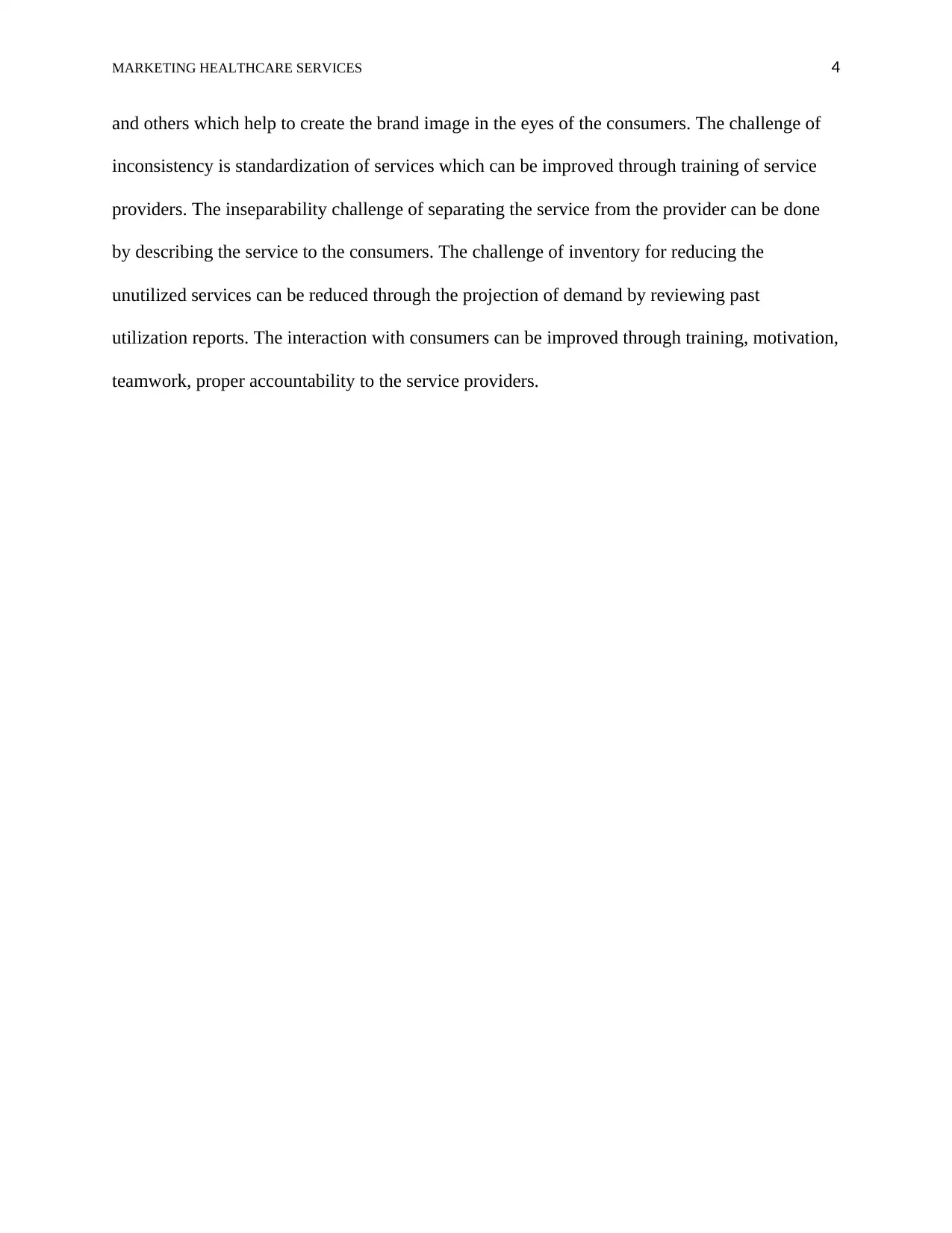
MARKETING HEALTHCARE SERVICES 4
and others which help to create the brand image in the eyes of the consumers. The challenge of
inconsistency is standardization of services which can be improved through training of service
providers. The inseparability challenge of separating the service from the provider can be done
by describing the service to the consumers. The challenge of inventory for reducing the
unutilized services can be reduced through the projection of demand by reviewing past
utilization reports. The interaction with consumers can be improved through training, motivation,
teamwork, proper accountability to the service providers.
and others which help to create the brand image in the eyes of the consumers. The challenge of
inconsistency is standardization of services which can be improved through training of service
providers. The inseparability challenge of separating the service from the provider can be done
by describing the service to the consumers. The challenge of inventory for reducing the
unutilized services can be reduced through the projection of demand by reviewing past
utilization reports. The interaction with consumers can be improved through training, motivation,
teamwork, proper accountability to the service providers.
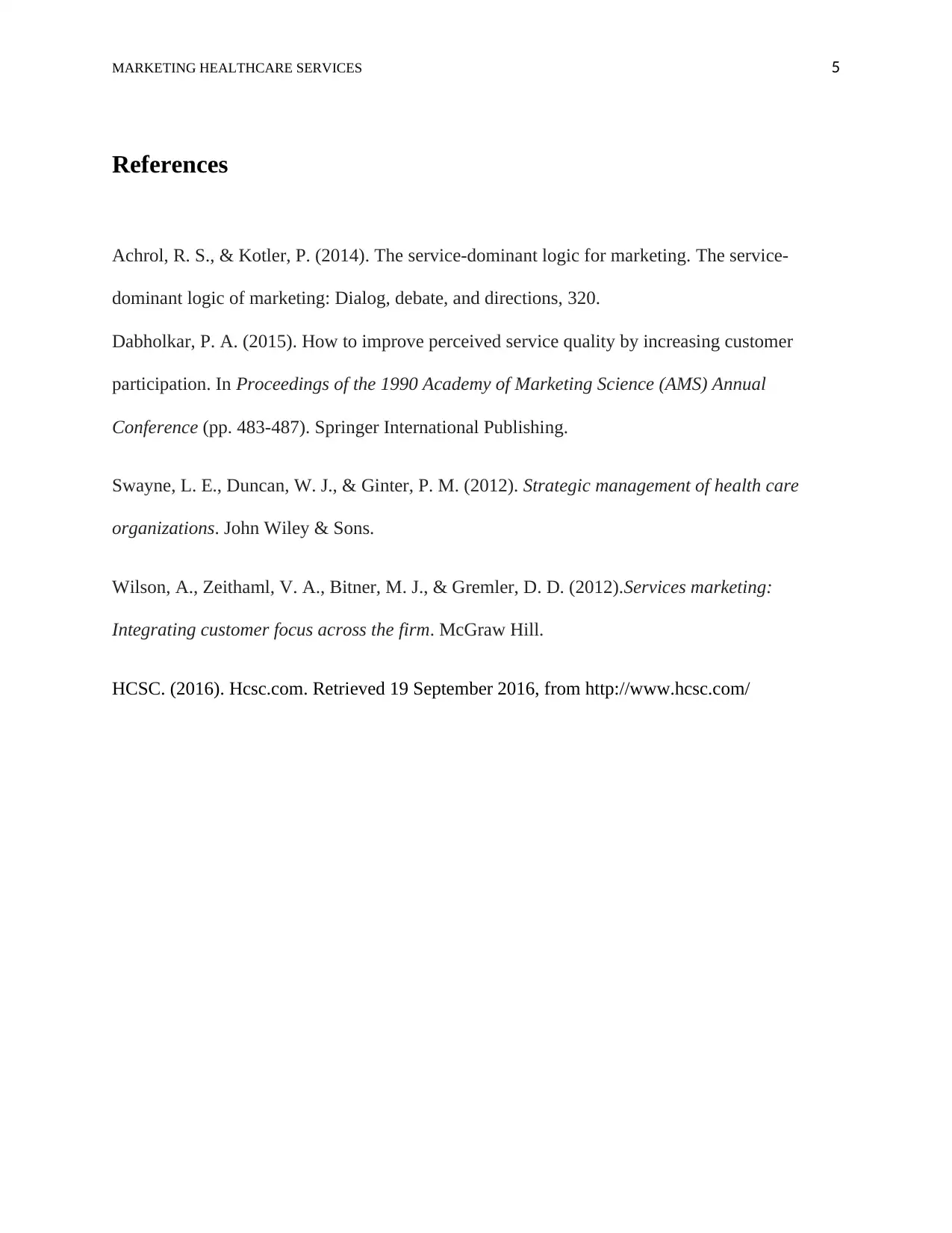
MARKETING HEALTHCARE SERVICES 5
References
Achrol, R. S., & Kotler, P. (2014). The service-dominant logic for marketing. The service-
dominant logic of marketing: Dialog, debate, and directions, 320.
Dabholkar, P. A. (2015). How to improve perceived service quality by increasing customer
participation. In Proceedings of the 1990 Academy of Marketing Science (AMS) Annual
Conference (pp. 483-487). Springer International Publishing.
Swayne, L. E., Duncan, W. J., & Ginter, P. M. (2012). Strategic management of health care
organizations. John Wiley & Sons.
Wilson, A., Zeithaml, V. A., Bitner, M. J., & Gremler, D. D. (2012).Services marketing:
Integrating customer focus across the firm. McGraw Hill.
HCSC. (2016). Hcsc.com. Retrieved 19 September 2016, from http://www.hcsc.com/
References
Achrol, R. S., & Kotler, P. (2014). The service-dominant logic for marketing. The service-
dominant logic of marketing: Dialog, debate, and directions, 320.
Dabholkar, P. A. (2015). How to improve perceived service quality by increasing customer
participation. In Proceedings of the 1990 Academy of Marketing Science (AMS) Annual
Conference (pp. 483-487). Springer International Publishing.
Swayne, L. E., Duncan, W. J., & Ginter, P. M. (2012). Strategic management of health care
organizations. John Wiley & Sons.
Wilson, A., Zeithaml, V. A., Bitner, M. J., & Gremler, D. D. (2012).Services marketing:
Integrating customer focus across the firm. McGraw Hill.
HCSC. (2016). Hcsc.com. Retrieved 19 September 2016, from http://www.hcsc.com/
⊘ This is a preview!⊘
Do you want full access?
Subscribe today to unlock all pages.

Trusted by 1+ million students worldwide
1 out of 6
Related Documents
Your All-in-One AI-Powered Toolkit for Academic Success.
+13062052269
info@desklib.com
Available 24*7 on WhatsApp / Email
![[object Object]](/_next/static/media/star-bottom.7253800d.svg)
Unlock your academic potential
Copyright © 2020–2025 A2Z Services. All Rights Reserved. Developed and managed by ZUCOL.





